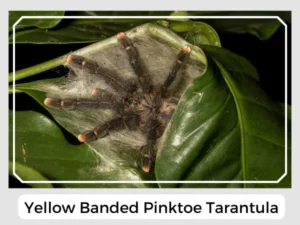Meet the yellow banded pinktoe tarantula! This colorful spider calls Brazil its home. Some people mix it up with the Amazonian pink toe spider. Ready to explore fun facts about this unique tarantula?
Females lay the eggs inside a giant sac, which they fiercely protect.
Immature spiderlings are initially brown before eventually beginning to resemble adults.
They create intricate silken retreats with webbing on trees.
Yes, Yellow Banded Pinktoe tarantulas have venom. They use it mostly to grab the bugs they love to eat. For most people, it’s not a major worry. However, it may have potential use as an anti-fungal agent.
They can indeed! While they’re generally calm creatures, they might bite if they feel threatened. But usually, they like to relax and show off their colorful legs.

Photo Credit: Jason Penney
The Yellow Banded Pinktoe tarantula is an integral part of the forest ecosystem, helping control insect populations and contributing to the biodiversity of its habitat. They exhibit arboreal behavior, spending much of their time in the trees which also aids in forest pollination.
Natural Predator: Birds, larger insects, and other predators pose a threat to these tarantulas in the wild, maintaining natural ecological checks and balances.
Prey-Predator Dynamics: As predators, they play a role in controlling the populations of their prey, which can include pest species. This predation is vital for the health of their forest environment.
Relationship with Humans: Humans have shown great interest in the Yellow Banded Pinktoe tarantula, often keeping them as pets due to their docile nature and striking appearance. However, capturing wild tarantulas can impact their native populations, highlighting the need for responsible pet trade practices.
| Lifespan | Males: 2-3 years, Females: 12 years |
| Distribution | Brazil (mainly the states of Mato Grosso and Rondônia) |
| Habitat | Forests |
| Diet | Crickets, grasshoppers, roaches, tiny frogs, and wax moths |
In conclusion, the Yellow Banded Pinktoe tarantula is not just a beautiful creature but also an important player in its ecological niche.
Meet the yellow banded pinktoe tarantula! This colorful spider calls Brazil its home. Some people mix it up with the Amazonian pink toe spider. Ready to explore fun facts about this unique tarantula?
Females lay the eggs inside a giant sac, which they fiercely protect.
Immature spiderlings are initially brown before eventually beginning to resemble adults.
They create intricate silken retreats with webbing on trees.
Yes, Yellow Banded Pinktoe tarantulas have venom. They use it mostly to grab the bugs they love to eat. For most people, it’s not a major worry. However, it may have potential use as an anti-fungal agent.
They can indeed! While they’re generally calm creatures, they might bite if they feel threatened. But usually, they like to relax and show off their colorful legs.

Photo Credit: Jason Penney
The Yellow Banded Pinktoe tarantula is an integral part of the forest ecosystem, helping control insect populations and contributing to the biodiversity of its habitat. They exhibit arboreal behavior, spending much of their time in the trees which also aids in forest pollination.
Natural Predator: Birds, larger insects, and other predators pose a threat to these tarantulas in the wild, maintaining natural ecological checks and balances.
Prey-Predator Dynamics: As predators, they play a role in controlling the populations of their prey, which can include pest species. This predation is vital for the health of their forest environment.
Relationship with Humans: Humans have shown great interest in the Yellow Banded Pinktoe tarantula, often keeping them as pets due to their docile nature and striking appearance. However, capturing wild tarantulas can impact their native populations, highlighting the need for responsible pet trade practices.
| Lifespan | Males: 2-3 years, Females: 12 years |
| Distribution | Brazil (mainly the states of Mato Grosso and Rondônia) |
| Habitat | Forests |
| Diet | Crickets, grasshoppers, roaches, tiny frogs, and wax moths |
In conclusion, the Yellow Banded Pinktoe tarantula is not just a beautiful creature but also an important player in its ecological niche.